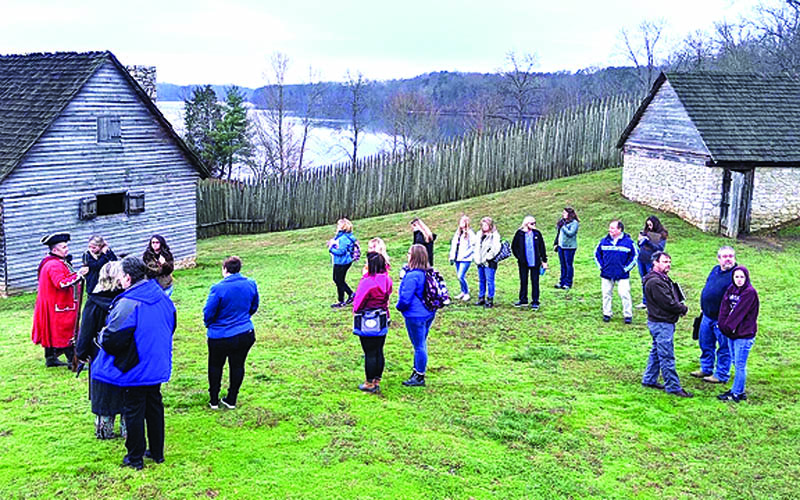To be deleted
Tennessee’s only French and Indian War fort

Park manager Eric Hughey in period costume at a teacher training event at Fort Loudoun Historic Park in 2019 (TN History for Kids photo).
The sad story of Fort Loudoun goes back to a time before the state of Tennessee and the United States of America existed.
It goes back to an era when present-day Tennessee was at the far reaches of the British empire. During the French and Indian War, South Carolina’s colonial government built a fort in present-day Monroe County called Fort Loudoun.
The fort, in the heart of Cherokee territory, was meant to ensure that the Cherokee nation fought against the French rather than the British during the war.
Cherokee chiefs were receptive to the idea of Fort Loudoun because they thought it would give them access to European-made goods for which they could trade.
When soldiers arrived in 1756 and began building the fort, they traded guns, powder, tools, iron cookware, clothes and other things with the Cherokee in exchange for deerskins that Cherokee hunters would bring.
Soldiers built the fort as a large, wooden, enclosed palisade with barracks, a blacksmith shop and various storehouses.
For the first couple of years after it was completed, things were cordial between the colonial soldiers and the neighboring Cherokee. Trade between them occurred on almost a daily basis.
Some of the soldiers’ wives came to live at the fort, and a few even had children. These are believed to be the first English children born west of the Appalachian Mountains.
But in 1758 and 1759 relations broke down between the colonists and the Cherokee on many fronts, mostly because of incidents that took place far away from Fort Loudoun.
There were several acts of violence between Cherokee and colonials in Virginia and South Carolina, often started by misunderstandings and driven by the desire to retaliate for other events.
When the general in charge of British forces in America ordered his men to stop trading arms and gunpowder with the Cherokee people, the Cherokee retaliated by refusing to trade with the soldiers.
Soon the fort was surrounded by hostile Cherokee warriors.
The British government sent an army to relieve Fort Loudoun, but that army was attacked and never made it through the mountains.
For much of 1760 the people inside the fort held out on the verge of starvation. Finally, in August, Captain Paul Demere of the British army surrendered the fort.
The 230 men, women and children were told that they would be allowed safe passage east across the mountains if they laid down their arms and turned over the fort’s 12 guns.
On August 9, the British garrison spent the night about 15 miles east, next to a small body of water called Cane Creek. The next morning Cherokee warriors attacked and killed about 30 people, including Captain Demere.
The rest of the soldiers and other people who had lived at Fort Loudoun were taken prisoner. Some died during the next few months, some were later exchanged back to the colonists, and some chose to live out the rest of their lives with the Cherokee.
History books refer to this attack on the English soldiers as the Fort Loudoun Massacre or the Cane Creek Massacre.
The Cherokee, however, believed this attack was justified revenge for the execution of Cherokee hostages at Fort Prince George, another colonial fort located in present-day western South Carolina.
The original Fort Loudoun was later burned to the ground. In the 1970s, when the Tennessee Valley Authority dammed up the Little Tennessee River, the site of Fort Loudoun was nearly immersed forever under the waters of Tellico Lake. Historians and archaeologists asked TVA not to flood the Fort Loudoun site, and so TVA agreed to a compromise.
First, archaeologists were sent in to dig up and study the former site of the fort, to help us learn more about it.
Then, TVA brought in huge amounts of dirt to elevate the former site of Fort Loudoun by 17 feet.
Since that time, a wonderful replica of the fort has been built. Today you can visit the rebuilt site.
It is physically accurate in as many ways as possible.
But when you get there you will have to imagine for yourself the sad story of what happened to the people who once lived there.
Bill Carey is the founder of Tennessee History for Kids, a nonprofit organization that helps teachers cover social studies.

